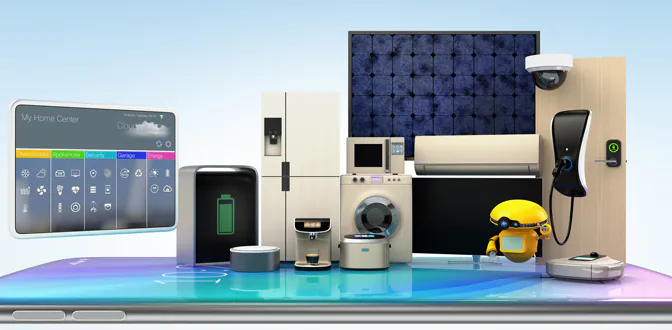Ease of operability and competitive pricing are the keys to any effective marketing strategy as determined by the consumer electronics industry. They aren’t wrong- this industry is rife with competition and shifting customer preferences now rest on innovation, compatibility and pricing.
2018 Insight – The influx of high technology has bestowed the ‘smart’ prefix on many examples of home electronics. Brand names, while still relevant, aren’t the final say in a purchase anymore. As exemplified by the following five market trends, the factors extend beyond just manufacturing and marketing in the consumer electronics industry.
1. Smart household appliances powered by IoT
Consumer electronics companies are integrating their products with the IoT technology to produce a breed of smart appliances. These can be controlled with a smartphone app, which simplifies the appliance’s operation and improves the operator’s comfort factor.
Another rung in this evolutionary ladder is personal assistants like Amazon’s Alexa and Google’s Home, which project their exemplary AI and machine learning capabilities to control functionalities and appliances around the house. Again, this concept is gaining wide traction in the US.
As is obvious, smart appliances are in demand and their prominence and adoption is likely to increase tremendously in 2018.

2. E-Commerce and Omnichannel retail bring in new customers
In 2018, any player in the consumer electronics industry cannot afford to have a weak online presence. With the growing influence of smartphones and the deep penetration of internet connectivity, consumer electronics companies can choose to not limit themselves to just brick-and-mortar stores.
Instead, a well-appointed e-commerce website will not only attract the target audience but will also affect actual sales and improve brand recognition and customer loyalty. This, alongside the adoption of strategies like omnichannel retail, is all about paying homage to the target demographic’s changing preferences. Particularly, in the case of millennials, the most cost-effective way to recruit new customers can be found on the internet.
3. Honest attempts to reduce the carbon footprint
The new age consumer is more deliberating, concerned and spoiled for choices than his/her counterpart from even just a decade ago. Meanwhile, the consumer electronics market has long held a very unconcerned approach towards the question of ecological responsibility.
Today, amid a global discussion on ecological conservation and responsible manufacturing procedures, ‘green’ has evolved to become an all-encompassing movement. Realistically, home electronics manufacturers that invest in eco-friendly fabrication procedures and operational upgrades that do not contribute significantly to their carbon footprint will find this ‘enlightened’ customer segment poised as their target demographic within the next two years.
4. Automation to ramp up production across the consumer electronics industry
In order to be an effective competitor, a consumer electronics company must first improve the efficiency and productivity levels at its own manufacturing facilities. This can be achieved with the introduction of wide serving automation and robotic inputs across production lines, inspection cycles, maintenance and logistics.
Also, this type of integration will tie in neatly with the growth of the allied automation and robotics industries, as the latter is projected to grow exponentially within the next five years. The singular concern will be the inclusive costs and the time needed to implement these broad changes.
5. Brand recognition influenced by customer outreach strategies
‘Stretching the connection a bit further’ will likely serve as the axiom for consumer electronics companies that understand the advantages of building a loyal consumer base, tending to it regularly and keeping prospective buyers away from the competition’s marketing radar.
When speaking of home electronics, a wide plethora of appliances are included. Thus, building a loyal customer base with the help of strategic customer outreach programs including contests, forums, social media engagement, and insightful content on well-appointed portals, will help a manufacturer engage an individual customer at different times for different sets of products and services.



